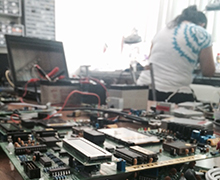Tremors in the system

Tremors in the system
- April 28, 2015
- Grad student explores politics behind Mexico’s public, early alert earthquake technology
-----
 When an 8.1 magnitude earthquake struck Mexico City in 1985, it and its aftershocks
devastated the capital, collapsing hundreds of structures and claiming the lives of
more than 10,000 people in a matter of days. In the aftermath of this natural disaster,
the government began funding development of the world’s first public early earthquake
alert system in hopes of preventing future tragedies. The Sistema de Alerta Sísmica
(SAS) launched in 1991 with only 12 sensory stations strung along the country’s west
coast. Now known as the Sistema de Alerta Sísmica Mexicano (SASMEX), it has grown
to include 98 sensory stations which detect earthquakes near their sources and issues
speedy warnings, giving people in population centers like Mexico City and Oaxaca crucial
seconds to evacuate or take shelter before quakes reach them.
When an 8.1 magnitude earthquake struck Mexico City in 1985, it and its aftershocks
devastated the capital, collapsing hundreds of structures and claiming the lives of
more than 10,000 people in a matter of days. In the aftermath of this natural disaster,
the government began funding development of the world’s first public early earthquake
alert system in hopes of preventing future tragedies. The Sistema de Alerta Sísmica
(SAS) launched in 1991 with only 12 sensory stations strung along the country’s west
coast. Now known as the Sistema de Alerta Sísmica Mexicano (SASMEX), it has grown
to include 98 sensory stations which detect earthquakes near their sources and issues
speedy warnings, giving people in population centers like Mexico City and Oaxaca crucial
seconds to evacuate or take shelter before quakes reach them.
SASMEX has successfully alerted Mexican people to hundreds of earthquakes since its
inception, but Beth Reddy, graduate student in cultural anthropology, suggests that
this life-saving system is not being utilized to its fullest potential. As California
scientists and policy makers work to develop a similar system here in the face of
significant budget and political constraints, Reddy’s final dissertation on the complexity
and politics behind Mexico’s system offers valuable insight into how early alert technology
can be used to prevent disaster — as well as what obstacles may present themselves
along the way.
“Although SASMEX is in schools and government offices, integrated into the subway
systems, broadcast on some TV and radio stations, on state-owned loudspeakers, in
some commercial spaces and increasingly available via personal smartphone apps, few
have heard of it,” she explains. “Many who have don't trust it despite its effectiveness,
or can't tell the difference between this advance alert and other, less effective
alarms that go off when earthquakes are actually shaking. Those are very different
kinds of things, and they should mean very different kinds of safety-oriented actions.”
The quality and timeliness of her dissertation research has caught the attention of
multiple foundations, earning Reddy more than $30,000 in fellowships, including a
UC Mexus Fellowship Award in the amount of $12,000 and a National Science Foundation
Fellowship Award for $15,120, to be paid through November 2015 and December 2015 respectively.
After completing her observations and conducting interviews and surveys throughout
Mexico City, Reddy used her findings to examine the complex relationship between science,
technology, and government, focusing on what she calls Mexico’s seismic politics.
She ultimately found that public safety in Mexico is more often approached from a
technical perspective, and that the background political and social work that scientists
and engineers conduct to make this technical work relevant is not being highlighted
as an essential part of disaster prevention. Reddy believes that the “social part”
of technical labor has serious implications in terms of how policymakers and ordinary
people understand and use — or fail to use — this system.
“SASMEX is, technically speaking, a great tool and only getting better as its scope
grows,” Reddy explains. “In the past few years, the size of its network has expanded
… [and] the collection of sensory field stations now spans much of the center and
southern parts of the nation, which means the system has a radically increased ability
to register earthquakes and send out alerts. It’s still growing. However, lack of
uptake is troubling.”
Reddy hopes her dissertation will be the start of further research on the subject
so that the system will be more widely used and more lives saved. As she continues
her own studies, she will work to encourage practical approaches to these kinds of
advanced technological tools. She is expected to complete her graduate program by
June 2016.
-Bria Balliet, Social Sciences Communications
-pictured: Technicians working on the Sistema Alerta Sismica Mexicano. Courtesy of
Beth Reddy.
-----
Would you like to get more involved with the social sciences? Email us at communications@socsci.uci.edu to connect.
Share on:
Related News Items
- Careet RightDickson receives grant to apply computational cognitive models to language acquisition
- Careet RightSocial sciences research at risk
- Careet RightI Dig UCI
- Careet RightWhy should you keep a lucky frog in your home, according to feng shui
- Careet RightAttending the National Conference for Black Political Scientists


